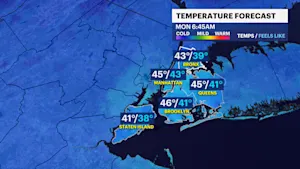Army Corps of Engineers plan would build seawalls, floodgates to prevent damage like Superstorm Sandy
Superstorm Sandy decimated parts of New York City when it hit land in 2012. The New York and New Jersey Harbor & Tributaries Focus Area Feasibility Study – or HATS – is a push by the federal government to make sure that never happens again.
Share:
More Stories

Category 4 Hurricane Melissa threatens catastrophic flooding in Jamaica and Haiti
5h ago1:46

Behind-the-scenes: How DSNY is gearing up for the first snow fall
6ds ago
LIVE RADAR: Track the nor'easter
13ds ago0:26

NYC Columbus Day parade canceled due to nor’easter
13ds ago1:17

Nor’easter: City Island prepares for strong winds and rain
14ds ago0:46

Coastal storm could impact weekend plans in Bronx
18ds ago
Category 4 Hurricane Melissa threatens catastrophic flooding in Jamaica and Haiti
5h ago1:46

Behind-the-scenes: How DSNY is gearing up for the first snow fall
6ds ago
LIVE RADAR: Track the nor'easter
13ds ago0:26

NYC Columbus Day parade canceled due to nor’easter
13ds ago1:17

Nor’easter: City Island prepares for strong winds and rain
14ds ago0:46

Coastal storm could impact weekend plans in Bronx
18ds agoSuperstorm Sandy decimated parts of New York City when it hit land in 2012. The New York and New Jersey Harbor & Tributaries Focus Area Feasibility Study – or HATS – is a push by the federal government to make sure that never happens again. It’s a multifaceted plan that’s being helmed by the U.S. Army Corps of Engineers.
“[It] involv[es] storm surge gates as well as shoreline-based measures, seawalls, flood walls...elevated promenades, a whole variety of different measures over what amounts to 80 miles of shoreline and about 2.2 miles of different waterways where the storm surge gates would be connected,” project manager Bryce Wisemiller told News 12 New York.
But Columbia University climate lecturer Paul Gallay thinks with recent New York City area flooding from the remnants of Hurricane Ida, for example, a lot more is needed than protection from storm surges.
“The trouble is they’re mainly focusing on hurricanes, not on the cloud bursts we’re seeing more and more frequently that are flooding people in their basements and turning our streets into rivers ... we’re looking at the new abnormal, some people call it the new normal, but it doesn’t look normal to me,” Gallay said.
He says flood walls can even trap cloud-based rain, creating more flooding. Gallay and Columbia University provided input on the study along with almost 3,000 other individuals and organizations when it was open for public comments. The U.S. Army Corps of Engineers recently requested a four-year extension on the project to address all of the input.
“We greatly appreciate the feedback that the public and stakeholder groups have given us ... We look towards trying to build a plan that might not be perfect, but that the region could endorse and advance,” Wisemiller said.
The city, of course, also has to endorse this project. News 12 New York reached out to the mayor’s office for comment, which said it fully supports advancing this project in order to protect the city. Early construction is expected to start in the 2030s.
More from News 12
1:55

Cold mornings ahead in The Bronx; rain possible midweek
0:20

FAA issues ground delays at tri-state airports
1:14

Bronx residents urged to prep for coastal flooding ahead of weekend storm
0:46

Coastal storm could impact weekend plans in Bronx

News 12 weather blog
1:44
